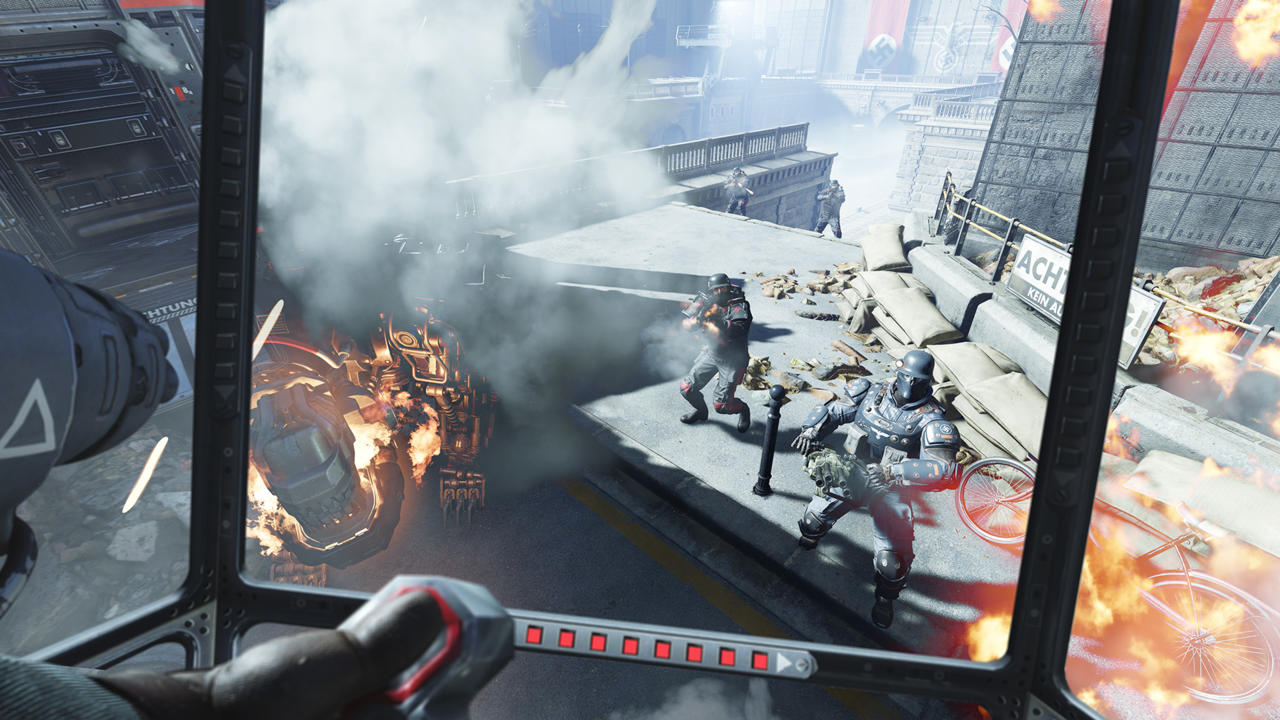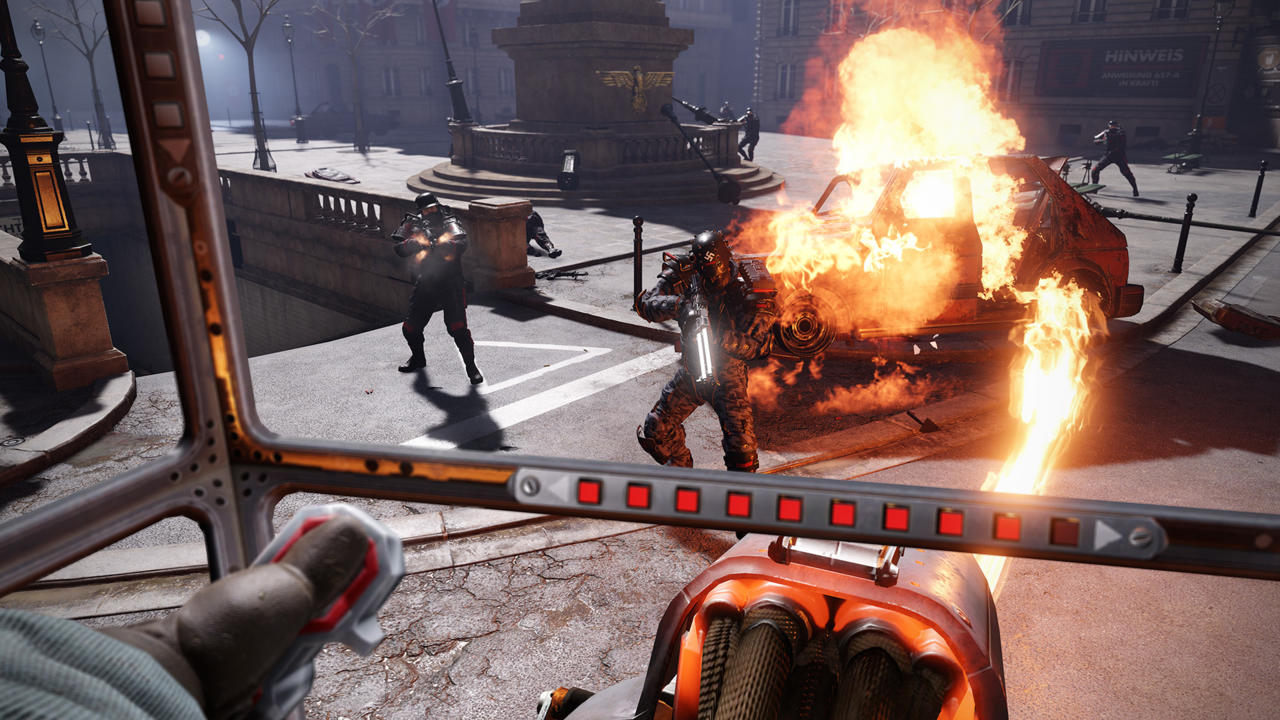With MachineGames at the helm, Wolfenstein has enjoyed a resurgence during the last couple of years. Wolfenstein has managed to captivate with its strong characters and intriguing world-building, giving you a glimpse into an alternate future where the rules are rewritten and whole new terrifying possibilities are waiting to be explored. None of this is present in the series' first venture into VR, however. Wolfenstein: Cyberpilot isn't just lacking the elements that make its universe intriguing, but it's also dated by recent VR standards, with flat, unexciting action and little reason to return after one short playthrough.
Set in 1980s, Cyberpilot puts you in the shoes of a pilot working for the French Resistance at the same time as the events in Wolfenstein: Youngblood. Your piloting skills are alluring to two French hackers who have managed to smuggle away a few Nazi war machines, giving you the chance to aim these monstrosities back at their creators. If you've ever cursed at being mauled by a Panzerhund, Cyberpilot initially seems like a great opportunity to flip the script.

It doesn't take long for that feeling to fade, though. Three of Cyberpilot's four missions give you control of a new machine to pilot. The Panzerhund lets you dash towards enemies before melting them down with a mouth-mounted flamethrower, a small airborne drone makes sneaking around a Nazi bunker simple, and the more straightforward Zitadelle arms you with a high-powered machine gun and rocket launchers. Despite these varied abilities, Cyberpilot doesn't provide interesting challenges for you to test them against. Each mission is linear and frustratingly one-note. You keep moving forward through cramped and visually bland spaces, mowing down enemies in your way and occasionally taking a breather to heal up before the next encounter. The drone mission at least tries to shake things up by pivoting from all-out action to stealthy engagements, but the unresponsive AI and cramped level design don't allow you the satisfaction of a well-planned stealth kill.
Since you're using machines armed with flamethrowers and unlimited rockets, combat should presumably be explosive and adrenaline-pumping. But Cyperpilot gives so little feedback to your actions that it's difficult to feel their impact at all. Enemies, for example, make no sounds when engulfed in flames or blown back by nearby explosions, and they almost always use the same animations when dying before disappearing from sight. The devastating weapons at your disposal offer no satisfying animations and subsequent sound effects that give them a real kick, which makes action feel limp and uninteresting.
In between each mission, you can explore a multi-floored resistance bunker, using a lift to transition from a spacious loading bay to a dimly lit reception area adorned in abandoned Nazi regalia. These spaces look great and do a good job of reminding you of the imposing grip your enemies still have on European soil. Although this bleeds into the handful of missions you're sent on, Cyberpilot doesn't offer anything new or interesting to say about this alternative perspective on the resistance. The only other characters are your resistance handlers, who occasionally engage in some quirky banter between each other, but outside of that you're nothing but a tool to them, and you disappointingly get no new insights into Wolfenstein's world as a result.
These brief interludes between missions also introduce you to each new pilotable machine in intimate fashion. Before being able to remotely control them, you need to hack your way past their security, which Cyberpilot makes out to be far more complicated than it really is. While you're being fed descriptions of intricate wiring and defensive subroutines, all you are doing is using motion controls to remove a chip from the machine in question, plugging it into a nearby monitor, and then replacing it after a brief pause. Getting to see the details of each chillingly monstrous Nazi machine up close, in VR, without fearing death is surprisingly fascinating, but there's not much else to do during these sequences. That makes each of these forced interludes feel drawn out and unnecessary.

Cyberpilot can be played with either the PlayStation Move controllers or a DualShock 4, and neither is great. With a DualShock 4, combat feels more familiar. You use the thumbsticks to freely move around and rotate (either smoothly or in adjustable segments) while using motion control to aim. In this configuration, your two hands move as one, which makes activities outside of combat a chore. The PlayStation camera can only track the front-facing light from the DualShock 4, so reaching for objects on either side of you is borderline impossible in some cases.
Using the Move controllers changes that immediately, and also gives you more freedom in combat. Moving your arms independently from one another lets you bash on your special attack button and heal at the same time, which is impossible to do when you're tethered together by a seemingly invisible set of handcuffs. As a tradeoff, movement is trickier using the Move controllers. Rotation is mapped to face buttons while lateral movement is controlled using the big, mushy PlayStation button on the face of the controller. It's far less ideal than the DualShock 4, leaving you with a decision to make between the lesser of two evils.
There's no reason to jump into Cyberpilot if you're looking for another avenue to explore more of Wolfenstein's world.
You won't have too much time to adjust, either, given that Cyberpilot's four missions can easily be finished in less than 90 minutes. Beyond reaching its flat ending, there's nothing else to do to make what time you do have more engaging. There are no collectibles to find, alternative mission routes to explore, or exciting mission set pieces to replay for the thrill of it. It gives Cyberpilot a distinct tech demo feeling; since VR games have become increasingly more adept at using the hardware in unique ways, Cyberpilot feels outdated by comparison.
There's no reason to jump into Cyberpilot if you're looking for another avenue to explore more of Wolfenstein's world. This straightforward shooter lacks the punch to make its action exhilarating and breaks up combat with even more repetitive and slower-paced interludes where you'll do the bare minimum with motion controls to achieve simple and mundane repair tasks. Beyond looking striking for a VR game in some places, there's nothing about Cyberpilot that warrants your time.


